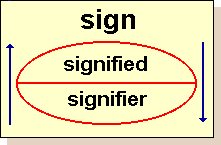-
Linguist Ferdinand de Saussure: two-part model of the sign:
- Philosopher Charles Sanders Peirce: three-part model for a sign:
- The Representamen: the form which the sign takes
- An Interpretant: not an interpreter but rather the Sense made of the sign;
- An Object: to which the sign refers.
Semiotics-very brief intro
Signifier -- spoken word, written word, flag, etc -- something that represents a concept.
Signified -- the concept that the signifer stands for.
For example: the word "cat" is the signifier, and the concept of a cat is the signified.
The two together constitute a SIGN

